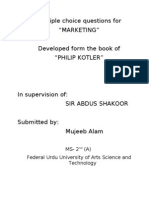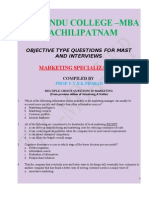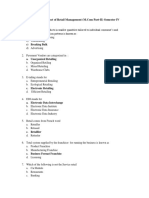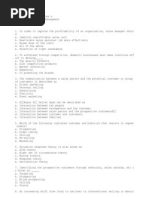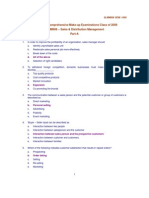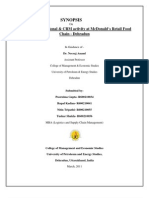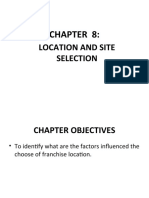Retail MCQ Marketing 2020
Retail MCQ Marketing 2020
Uploaded by
Akshay jireCopyright:
Available Formats
Retail MCQ Marketing 2020
Retail MCQ Marketing 2020
Uploaded by
Akshay jireOriginal Description:
Copyright
Available Formats
Share this document
Did you find this document useful?
Is this content inappropriate?
Copyright:
Available Formats
Retail MCQ Marketing 2020
Retail MCQ Marketing 2020
Uploaded by
Akshay jireCopyright:
Available Formats
MCQ -Retail Management-SEM-III- Marketing-2020-By Prof.Satish Kadam.
1. The word “retail” has been derived from which word?
a. Latine
b. French
c. Greek
d. Persian
2. Who is the last link in the chain connecting the producer and customer?
a. wholesaler
b. agent
c. retailer
d. storekeeper
3. Internet marketing and telemarketing are the recent trends in ………..
business
a. retail
b. wholesale
c. conventional
d. manufacturing
4. In the distribution channel … has the direct touch with consumers.
a. producer
b. wholesaler
c. agent
d. retailers
5.MRP stands for.
a. minimum retail price
b. maximum retail price
c. minimum rate of profit
d. maximum rate of profit
6. Multiple shops are also known as –
a. self-service stores
b. chain stores
c. shopping by post
d. departmental stores
7. Door to door selling is carried out by
a. hawkers and peddlers
b. cheap jacks
c. second shop
d. retailers
8. There is no shop assistants in a
a. super bazaar
b. departmental store
c. multiple shop
d. second shop
9. No middle men is involved in –
a. wholesale trade
b. retail trade
c. direct marketing
d. indirect marketing
10. Shopping malls, super markets and hypermarkets come under which
type of marketing?
a. wholesale
b. retail
c. direct marketing
d. agent service
11. Which of the following statement about retail marketing is true
a. sells products to other businesses
b. sells products to a company that resells them
c. sells products to final consumers
d. sells products for one's own use
12. A multi-channel retailer sells merchandise
a. over telephone
b. through retail stores
c. over internet
d. over more than one channel
13. E-retailing refers to
a. sales of electronic items
b. catalogue shopping
c. computerized store
d. retailing and shopping through internet
14. What is the full form of VAT?
a. value added tax
b. very important additional tax
c. value additional tax
d. value added theory
15. Mail order retailing is the same as:
a. Direct selling
b. In Home retailing
c. E-tailing
d. Catalogue retailing
16. All of the following are types of non-store retailing, except
a. Catalogue retailing
b. Vending Machines
c. Chain store
d. Direct Mail
17. Person to person interaction between a retailer and a prospective
customer is:
a. Direct marketing
b. Automatic selling
c. Direct selling
d. Buying service
18. Independent retailers who use a central buying organization and joint
promotional efforts are called a
a. merchandising conglomerate
b. corporate chain store
c. retailer cooperative
d. voluntary chain
19. A retail firm owned by its customers in which members contribute
money to open their own store, vote on its policies, elect a group to
manage it, and receive dividends is called a
a. corporate chain store.
b. merchandising conglomerate
c. voluntary chain
d. consumer cooperative
20. The oldest and most heavily trafficked city area is called
a. regional shopping centre
b. prime location
c. urban district
d. Central business district
21. Giant retailers called _____ concentrate on one product category such
as toys or home improvement
a. Category killers
b. Variety stores
c. supercentres
d. box stores
22. Retailers such as Benetton, The Body Shop, and Marks and Spencer
carry mostly own- brand merchandise. These are called _____ brands
a. creative label
b. private label
c. house
d. retail label
23. A_____ fee is the charge many supermarkets impose for accepting a
new brand to cover the cost of listing and stocking it.
a. inventory
b. slotting
c. initiation
d. stocking
24. Which of the following is not one of the four major decisions that
must be made with regard to market logistics?
a. How should orders be handled?
b. Where should stock be located?
c. How much stock should be held?
d. How should stock be financed?
25. Which statement is not a benefit of formulating a retail strategy?
a. A retailer is forced to study the legal, economic, and competitive
market
b. A retailer is shown how it can differentiate itself from competitors.
c. Sales maximization is stressed.
d. Crises are anticipated and often avoided.
26. A retailer's commitment to a type of business and to a distinctive role
in the marketplace is it’s
a. objectives
b. organizational mission
c. retailing concept
d. image
27. Which form of organization is subject to double taxation?
a. sole proprietorship
b. partnership
c. corporation
d. franchise
28. When retailers identify customer segments and develop unique
strategies to meet the desires of these segments, they are using:
a. mass merchandising
b. niche retailing
c. bifurcated retailing
d. middle market retailing
29. Those aspects of business that a retailer can directly affect, such as
store hours and merchandise lines carried are referred to as:
a. controllable variables
b. demographic statistics
c. lifestyle measures
d. uncontrollable variables
30. Which is not considered one of the elements of "managing a
business" in a retail strategy?
a. the retail organization
b. human resource management
c. operations management
d. merchandise management and pricing
31. A systematic procedure for analysing the performance of a retailer is
called:
a. control
b. feedback
c. strategic planning
d. retail audit
32. During each stage in the development of a retail strategy, retail
managers should:
a. considers only controllable variables
b. refrain from "fine tuning" the strategy
c. looks for both positive and negative feedback
d. considers no problems with the government to be a form of negative
feedback
33. Which of the following is a recommended strategy for retailers when
consumers select the outlet first and the brand second?
a) Appropriate pricing
b) Brand availability advertising
c) Brand image management
d) Price special on brands
e) Co-op ads featuring brands
34. Which of the following types of retail businesses have unlimited
liability?
a. Partnership and sole trader
b. Partnership and private company
c. Private company and sole trader
d. Private company and public company:
35. Any source of products or services for consumers is referred to as a
_____.
a) Retail outlet
b) Contact point
c) Transaction point
d) Distribution outlet
e) Channel outlet
36. The retailer is usually in an excellent position to
a. Make the most profits in the channel
b. Be the channel leader
c. Gain feedback from consumers
d. Co-ordinate the production strategy
37. Consumers acquiring product through mail, telephone, or computer
orders is referred to as _____.
a) Outsourcing
b) Outlet shopping
c) Non-traditional shopping
d) In-home shopping
38. Which of the following is the major reason consumers give for
shopping online?
a) Want product delivered
b) Unique merchandise
c) Price
d) Convenience
39. Which one of the following is NOT a form of direct marketing?
a. catalogue retailing
b. telemarketing
c. personal selling
d. direct mail
40. The major reason people give for not shopping on the Internet is
_____.
a) Lack of “touch”
b) Security concerns
c) Too difficult
d) Unfamiliar merchants
41. The difference between retail and cost is called:
a. profit
b. markdown
c. income
d. mark-up
42. Expenses that benefit the entire store are called:
a. controllable
b. direct
c. indirect
d. Margin results
43. Consumers who browse and/or purchase in more than one channel are
known as _____.
a) cosmopolitan
b) Multi-channel shoppers
c) multi-taskers
d) Market mavens
44. In which of the following retailers are salespeople ready to assist in
every phase of the locate-compare-select process?
a. self-service.
b. self-selection.
c. limited service.
d. full service.
45. The fastest growing segment of retailing is __________.
a. nonstore retailing
b. warehouse stores
c. hypermarkets
d. Category killers
46. The most important retail marketing decision a retailer has to make is
to __________.
a. identify its target market
b. choose the right service response it wants to support
c. select the service mix
d. Develop a nice store atmosphere
47. __________ includes all of the activities involved in selling goods or
services to those who buy for resale or business use.
a. retailing
b. wholesaling
c. bartering
d. Purchasing
48. A concept in retailing that helps explain the emergence of new
retailers is called the _______________ hypothesis.
a. retail life cycle
b. wheel-of-retailing
c. service-assortment
d. Product life cycle
49. Merchandising and display are an important part of the marketing
plan and should have a reasonable budget allocated, even for a retailer
operating on a ..........
a. corner.
b. dime.
c. limit.
d. Shoestring.
50. A retailer’s ______________ is the key to its ability to attract
customers.
a. location.
b. pricing system.
c. promotion system.
d. Store personnel.
51. Which of the following is NOT an example of non-store retailing?
a. mail order.
b. party plan
c. department store
d. Catalogue shop.
52. The word Retail is derived from the----- word
a. latin
b. french
c. english
d. none of these
53. In retailing there is a direct interaction with-------
a. producer
b. customer
c. wholesaler
d. all of these
54. Retailing creates-------
a. time utility
b. place utility
c. ownership utility
d. all of these
55. Retailing is a marketing function which ----
a. sells products to other business
b. sells products to a company that resells
c. sells products to final consumers
d. sells products for one’s own use
56.Retailers offering products in smaller quantities tailored to individual
consumer’s and household’s consumption patterns is known as
a) Visual Merchandising
b) Warehousing
c) Breaking Bulk
d) Advertising
57. Pavement Vendors are categorized in
a. Unorganized Retailing
b. Organized Retailing
c. Mixed Retailing
d. Warehouse Clubs
58 E-tailing stands for
a. Entrepreneurial Retailing
b. Ecological Retailing
c. Electronic Retailing
d. Efficient Retailing
59. EDI stands for
a. Electronic Data Interchange
b. Electronic Data Institute
c. Electronic Data Insurance
d. Electronic Data Industry
60. Retail comes from French word
a. Retuiller
b. Retaaail
c. Retaillier
d. Retteeler
61. Total system supplied by the franchisor for running the business is known as
a. Product Franchise
b. Manufacturing Franchise
c. Business Format Franchise
d. Licensing
62. Which of the following is not the Service retail
a. Car Rentals
b. Restaurants
c. Banking
d. Brick and Mortar
63.Which of the following is not the stage in the process of Wheel of Retailing
a. Entry Phase
b. Trade-up Phase
c. Introduction Phase
d. Vulnerable Phase
64.Accordian Theory is also known as
a. General-Specific-General Theory
b. Theory of Natural Selection
c. Theory of Wheel of Retailing
d. McNair’s Theory
65. A large building complex with a conglomeration of shops is known as
a. Mall
b. Hyper Market
c. Supermarket
d. Co-operative Store
66. The premise on which retailing activity takes place is called ____________
a. Place
b. Market
c. Store
d. Office
67. The retail organization loses its _________ edge at decline stage
a. Competitive
b. Promotion
c. Positioning
d. Segmenting
68. Which is last stage in Consumer Buying Process
a. Need Recognition
b. Evaluation
c. Post Purchase
d. Information Search
69. Which of the following is not the Commercial Sources of Consumer
Information
a. Displays
b. Packaging
c. Acquaintances
d. Websites
70. ____________ has identified various elements that go into the composition
of a value chain
a. Darwin
b. Michael Porter
c. Philip Kotler
d. Deming
71. _________________ are the activities associated with collecting, storing
and physically distributing the product to buyer
a. Inbound Logistics
b. Distribution
c. Warehousing
d. Outbound Logistics
72. High employee turnover is _____________challenge in Retail
a. Marketing
b. Human Resources
c. Finance
d. Operation
73. ____________ are printed on the packs or in store handouts, usually
allowing a substantial savings on the next purchase of the brand.
a. Leaflets
b. Pack Designs
c. Price-off Coupons
d. Price-off Packs
74. _________ is a branch of philosophy that deals with values relating to
human conduct, with respect to good and wrong or bad actions and has
relevance in retail too
a. Social Class
b. Ethics
c. Social Stratification
d. Religion
75. ___________ are bigger and transparent and show much of what is going on
in-store
a. Window Displays
b. Gondolas
c. Racks
d. Shelves
Answers 1.b 2.c 3.a 4. d 5.b 6. b 7.a 8.a 9.c 10.b 11.c 12.d 13.d 14.a 15.d 16.c
17.c 18.c 19.d 20.d 21.a 22.b 23.b 24.d 25.c 26.b 27.c 28.b 29.a 30.d 31.d 32.c
33.a 34.a 35.a 36.c 37.d 38.d 39.c 40.b 41.d 42.c 43.b 44.d 45.a 46.a 47.b 48.b
49.d 50.a 51.d 52.a 53.d 54.d 55.c 56.c,57.b,58.c,59.d,
60.c,61.c,62.d,63.d,64.d,65.a,66.c,67.a,68.c,69.d,70.d,71.b,72.d,73.a,74.b,75.a.
You might also like
- Marketing Multiple Choice Questions With Answers.Document43 pagesMarketing Multiple Choice Questions With Answers.Mujeeb Alam80% (66)
- Sales Management Multiple Choice Questions and Answers PDFDocument13 pagesSales Management Multiple Choice Questions and Answers PDFjayant bansal73% (11)
- National Common Mobility Card NCMC RuPay QSPARC Dual Interface Card NPCIDocument15 pagesNational Common Mobility Card NCMC RuPay QSPARC Dual Interface Card NPCISharad KumarNo ratings yet
- Chapter 12 Marketing Channels and Supply Chain ManagementDocument32 pagesChapter 12 Marketing Channels and Supply Chain ManagementWilliam Zhang100% (1)
- Examples of Examination Questions: Multiple ChoiceDocument12 pagesExamples of Examination Questions: Multiple ChoiceSreekanth NagloorNo ratings yet
- Test Paper 1 - MarketingDocument4 pagesTest Paper 1 - MarketingAbhijit DasNo ratings yet
- Retail Marketing and Branding: A Definitive Guide to Maximizing ROIFrom EverandRetail Marketing and Branding: A Definitive Guide to Maximizing ROIRating: 5 out of 5 stars5/5 (1)
- Chapter 2: HospitalityDocument35 pagesChapter 2: Hospitalityallya100% (1)
- Home DepotDocument8 pagesHome DepotRajesh KumarNo ratings yet
- The Buying Cycle and Tools of MerchandisingDocument22 pagesThe Buying Cycle and Tools of MerchandisingGarima Dhiman100% (1)
- Strategy Review of FedExDocument21 pagesStrategy Review of FedExMinh Kei100% (1)
- Retail MCQDocument13 pagesRetail MCQDavid Shrsth0% (1)
- 506 B Retail ManagmentDocument11 pages506 B Retail ManagmentNilesh PatilNo ratings yet
- RM MCQDocument19 pagesRM MCQBattina Abhisek100% (2)
- Module 1 MCQS: Ankita Agarwal, Asst. Prof., BIITMDocument7 pagesModule 1 MCQS: Ankita Agarwal, Asst. Prof., BIITMSaisrita PradhanNo ratings yet
- AnswerDocument21 pagesAnswerarkarmyatmoe546No ratings yet
- Chapter 13 Retailers Wholesalers and Direct MarketersDocument29 pagesChapter 13 Retailers Wholesalers and Direct MarketersWilliam ZhangNo ratings yet
- (MOE) Model Exit ExamDocument15 pages(MOE) Model Exit ExamtimketaNo ratings yet
- TYBMS - Retail ManagementDocument18 pagesTYBMS - Retail ManagementRithik ThakurNo ratings yet
- MB0030 Marketing Management-Model Question PaperDocument19 pagesMB0030 Marketing Management-Model Question PaperBari Shaikh67% (6)
- MOE Exit Exam (2015)Document15 pagesMOE Exit Exam (2015)birukbizuneh6No ratings yet
- SDMDocument6 pagesSDMMonika GuptaNo ratings yet
- RevisionDocument10 pagesRevisiondinhnquanganh25No ratings yet
- MCQ's Sales and Distribution Management: ConsumersDocument6 pagesMCQ's Sales and Distribution Management: Consumersjaitripathi26100% (1)
- MCQ On Marketing ManagementDocument39 pagesMCQ On Marketing ManagementtusharNo ratings yet
- Retail Management Info BankDocument3 pagesRetail Management Info Bankharsh agarwal0% (1)
- SalesDocument6 pagesSalesVikas NainNo ratings yet
- MM MerDocument483 pagesMM Meraanchal gargNo ratings yet
- Fairooz MCQDocument22 pagesFairooz MCQFairooz AliNo ratings yet
- The Hindu College - Mba Machilipatnam: Marketing SpecializationDocument29 pagesThe Hindu College - Mba Machilipatnam: Marketing SpecializationSabri Binkasim100% (1)
- Chapter 1Document6 pagesChapter 1P XVinh100% (1)
- MULTIPLEDocument27 pagesMULTIPLETage Nobin100% (1)
- MKTQSMMMMMDocument26 pagesMKTQSMMMMMmayankNo ratings yet
- Mcom II MGMT Retail Management Practice QuestionsDocument3 pagesMcom II MGMT Retail Management Practice QuestionsKaran Veer SinghNo ratings yet
- Mcom II MGMT Retail Management Practice QuestionsDocument3 pagesMcom II MGMT Retail Management Practice QuestionsAryan MehtaniNo ratings yet
- Principles of Marketing 3rd Quarter ExamDocument5 pagesPrinciples of Marketing 3rd Quarter ExamanamayamigoNo ratings yet
- Fairooz MCQDocument22 pagesFairooz MCQFairooz AliNo ratings yet
- Important Marketing Questions-PDocument53 pagesImportant Marketing Questions-Psaubhagyatripathy61No ratings yet
- 25 Marketing Multiple Choice QuestionsDocument13 pages25 Marketing Multiple Choice QuestionsRamdass YogiNo ratings yet
- MKTG 404 International Marketing 2Document15 pagesMKTG 404 International Marketing 2thomasNo ratings yet
- Multiple Choice Questions: Tybms Sem Vi Retail ManagementDocument8 pagesMultiple Choice Questions: Tybms Sem Vi Retail ManagementprashantNo ratings yet
- MCQ Brand MarketingDocument15 pagesMCQ Brand MarketingDr. Shailendra Kumar SrivastavaNo ratings yet
- Sales and Distribution ManagementDocument4 pagesSales and Distribution ManagementASHWINI SINHA100% (1)
- Wa0024.Document42 pagesWa0024.Vaishali AggarwalNo ratings yet
- Principles of Marketing Summative TestDocument3 pagesPrinciples of Marketing Summative TestanamayamigoNo ratings yet
- Test Paper 1 - MarketingDocument5 pagesTest Paper 1 - MarketingAbhijit DasNo ratings yet
- For Exam (STG)Document29 pagesFor Exam (STG)Gunay GozalovaNo ratings yet
- BUSINESS 12 Exam 4th QDocument4 pagesBUSINESS 12 Exam 4th QDan AndresNo ratings yet
- Sde651 PDFDocument17 pagesSde651 PDFIndujaNo ratings yet
- Marktng 2 Fi̇nal SorulariDocument5 pagesMarktng 2 Fi̇nal SorulariKatre-i MatemNo ratings yet
- AssamDocument4 pagesAssamAbhijit DasNo ratings yet
- Sales & Distribution Management WorkbookDocument16 pagesSales & Distribution Management Workbookanindya_kunduNo ratings yet
- Unlock Multi-Channel Profits: Proven Strategies for Business GrowthFrom EverandUnlock Multi-Channel Profits: Proven Strategies for Business GrowthNo ratings yet
- Embarrassment of Product Choices 1: How to Consume DifferentlyFrom EverandEmbarrassment of Product Choices 1: How to Consume DifferentlyNo ratings yet
- Marketing and Sales Strategies: Maximize Your Sales Performance with This Comprehensive Guide to Marketing and Selling StrategiesFrom EverandMarketing and Sales Strategies: Maximize Your Sales Performance with This Comprehensive Guide to Marketing and Selling StrategiesNo ratings yet
- Project Report ON: Plastic MoneyDocument55 pagesProject Report ON: Plastic MoneyDisha100% (1)
- Factors Affecting Consumer Buying Behavior: September 2016Document6 pagesFactors Affecting Consumer Buying Behavior: September 2016LohithKumar JAINNo ratings yet
- Avinash Jha SIP Project - Report - Mba17h01Document39 pagesAvinash Jha SIP Project - Report - Mba17h01AVINASH JHANo ratings yet
- CVP Review QuestionsDocument6 pagesCVP Review QuestionsCharlie True Friend100% (1)
- Beatty, Ferrell - 1988 - Impulse Buying Modeling Its Precursors PDFDocument23 pagesBeatty, Ferrell - 1988 - Impulse Buying Modeling Its Precursors PDFDante EdwardsNo ratings yet
- My Project On Coco Cola CompanyDocument77 pagesMy Project On Coco Cola CompanyanuragNo ratings yet
- Research Report - Vipshop Holdings LimitedDocument5 pagesResearch Report - Vipshop Holdings LimitedGlen BorgNo ratings yet
- Vertical Integration A Preliminary InsightDocument4 pagesVertical Integration A Preliminary InsightInternational Journal of Innovative Science and Research TechnologyNo ratings yet
- IKEA CartDocument1 pageIKEA CartMark Anthony LimNo ratings yet
- Synopsis MCDDocument7 pagesSynopsis MCDRupal KadiyanNo ratings yet
- Introduction SCMDocument55 pagesIntroduction SCMUsama Jahangir BabarNo ratings yet
- Channel ManagementDocument8 pagesChannel Managementsajid bhattiNo ratings yet
- Ugam Content Solutions BrochureDocument4 pagesUgam Content Solutions BrochureNeha KamatNo ratings yet
- Unit 3 MKIS and Buyer BehaviorDocument38 pagesUnit 3 MKIS and Buyer BehaviorBHAKT Raj BhagatNo ratings yet
- Sip ProjectDocument108 pagesSip ProjectPiyush NavaleNo ratings yet
- Gucci Case Study EssaysDocument22 pagesGucci Case Study EssaysLucas ChanNo ratings yet
- OPERATION Management in BusinessDocument17 pagesOPERATION Management in Businessrayhan555No ratings yet
- Location and Site SelectionDocument12 pagesLocation and Site SelectionShiMeiChan100% (1)
- Mrtssales92 PresentDocument50 pagesMrtssales92 PresentGowtham Krishna MagantiNo ratings yet
- 40 Awesome Coffee Packaging PDFDocument29 pages40 Awesome Coffee Packaging PDFGeorge PetrakosNo ratings yet
- Essenxia: Sales and Inventory SystemDocument12 pagesEssenxia: Sales and Inventory SystemBryan Lasaga CabridoNo ratings yet
- Dr. Syed Mithun Ali, Department of IPE, BUET, Dhaka: AEM 6209: Supply Chain ManagementDocument45 pagesDr. Syed Mithun Ali, Department of IPE, BUET, Dhaka: AEM 6209: Supply Chain ManagementRajib DebnathNo ratings yet
- Alberto Giacometti - The Art of RelationDocument2 pagesAlberto Giacometti - The Art of RelationGeorgiaPanteli0% (1)
- Capstone Project Report On FMCG (Fast-Moving Consumer Goods) Patanjali AyurvedaDocument6 pagesCapstone Project Report On FMCG (Fast-Moving Consumer Goods) Patanjali Ayurvedajini jainNo ratings yet
- Negotiations in Industrial BuyingDocument12 pagesNegotiations in Industrial BuyingMiguel HernandezNo ratings yet
